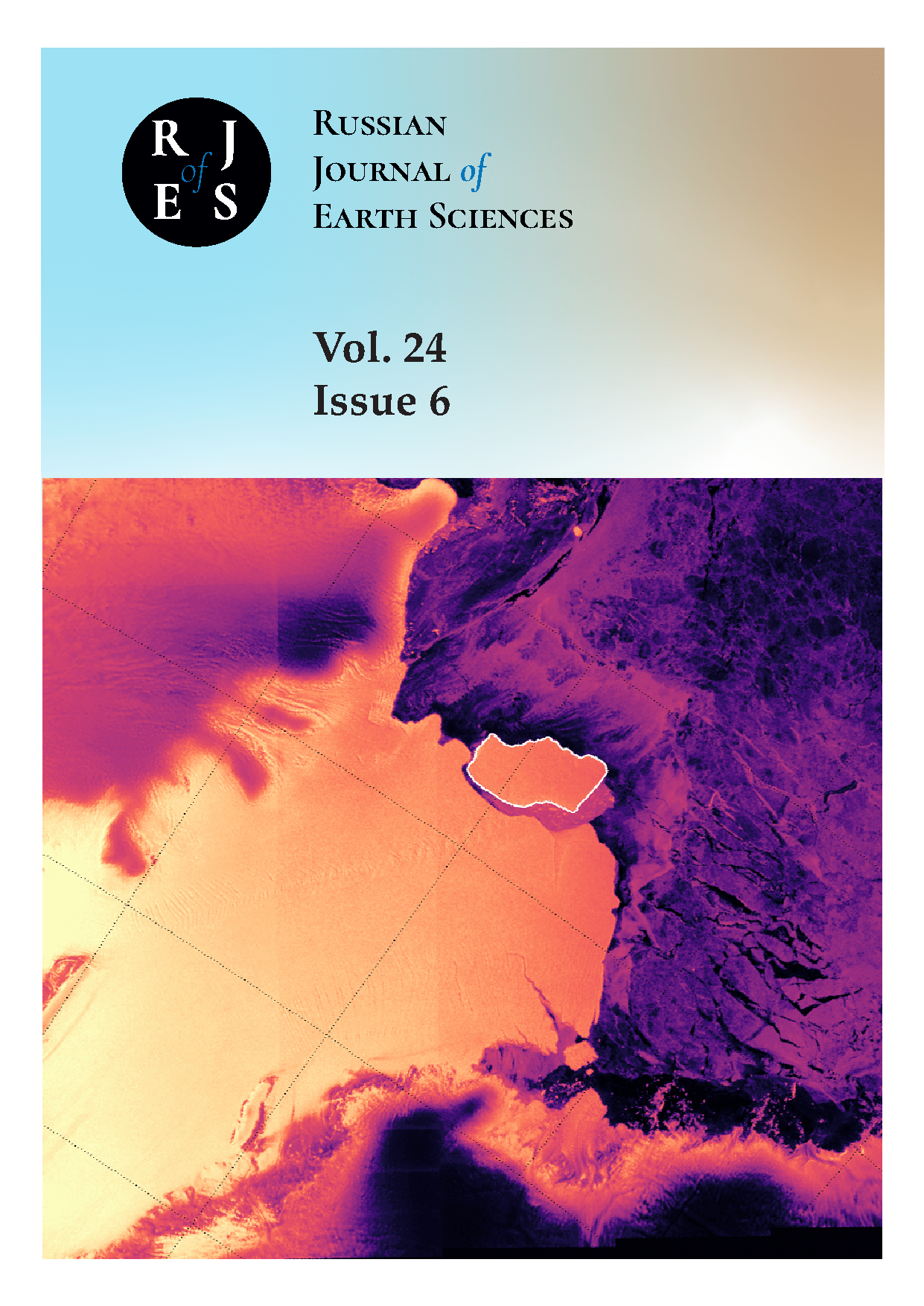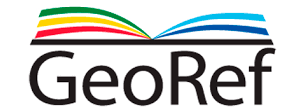Sevastopol, Russian Federation
Sevastopol, Russian Federation
UDC 556
UDC 55
UDC 550.34
UDC 550.383
CSCSTI 37.01
CSCSTI 37.15
CSCSTI 37.25
CSCSTI 37.31
CSCSTI 38.01
CSCSTI 36.00
CSCSTI 37.00
CSCSTI 38.00
CSCSTI 39.00
CSCSTI 52.00
Russian Classification of Professions by Education 05.00.00
Russian Library and Bibliographic Classification 26
Russian Trade and Bibliographic Classification 63
BISAC SCI SCIENCE
The goal of the article is to track down the giant tabular iceberg D28 trajectory from its calving in September 2019 from Amery Ice Shelf until reaching the western part of the Weddell Sea in March 2023 and to present characteristics of the iceberg state and movement, derived from satellite radar data. The Maximally Stable Extremal Regions (MSER) method, which used as an imagery recognition technique for time-dependent visual conditions, has been applied to automatically identify iceberg’s positions. On the basis of the Sentinel-1A/B SAR data during 1,275 days, timeseries of D28 location, spatial orientation, mass, area, moment of inertia, linear and angular velocity, kinetic and rotational energy, grounding location are presented. D28 dynamics display strongly pronounced regionality, generalized into the three distinct sections of its drift along the Antarctic coast. These sections are in good agreement with existent concepts in the oceanographic literature, concerning the system of Antarctic Slope Current / Antarctic Slope Front.
Antarctic, iceberg D28, iceberg dynamics, satellite radar imaging, iceberg grounding, Antarctic Slope Current
1. Azaneu, M., K. J. Heywood, B. Y. Queste, and A. F. Thompson (2017), Variability of the Antarctic Slope Current System in the Northwestern Weddell Sea, Journal of Physical Oceanography, 47(12), 2977–2997, https://doi.org/10.1175/JPO-D17-0030.1.
2. Barbat, M. M., T. Rackow, C. Wesche, et al. (2021), Automated iceberg tracking with a machine learning approach applied to SAR imagery: A Weddell sea case study, ISPRS Journal of Photogrammetry and Remote Sensing, 172, 189–206, https://doi.org/10.1016/j.isprsjprs.2020.12.006. EDN: https://elibrary.ru/BGVJVQ
3. Barnes, D. K. A., and T. Souster (2011), Reduced survival of Antarctic benthos linked to climate-induced iceberg scouring, Nature Climate Change, 1(7), 365–368, https://doi.org/10.1038/nclimate1232. EDN: https://elibrary.ru/JRZMRB
4. Budge, J. S., and D. G. Long (2018), A Comprehensive Database for Antarctic Iceberg Tracking Using Scatterometer Data, IEEE Journal of Selected Topics in Applied Earth Observations and Remote Sensing, 11(2), 434–442, https://doi.org/10.1109/JSTARS.2017.2784186.
5. Canny, J. (1986), A Computational Approach to Edge Detection, IEEE Transactions on Pattern Analysis and Machine Intelligence, PAMI-8(6), 679–698, https://doi.org/10.1109/TPAMI.1986.4767851.
6. Emery, W. J., C. W. Fowler, and J. A. Maslanik (1997), Satellite-derived maps of Arctic and Antarctic sea ice motion: 1988 to 1994, Geophysical Research Letters, 24(8), 897–900, https://doi.org/10.1029/97GL00755.
7. Francis, D., K. S. Mattingly, S. Lhermitte, M. Temimi, and P. Heil (2021), Atmospheric extremes triggered the biggest calving event in more than 50 years at the Amery Ice shelf in September 2019, The Cryosphere, 15, 2147–2165, https://doi.org/10.5194/tc-2020-219. DOI: https://doi.org/10.5194/tc-15-2147-2021; EDN: https://elibrary.ru/CYDFLX
8. Fricker, H. A., N. W. Young, I. Allison, and R. Coleman (2002), Iceberg calving from the Amery Ice Shelf, East Antarctica, Annals of Glaciology, 34, 241–246, https://doi.org/10.3189/172756402781817581. EDN: https://elibrary.ru/MBHCWP
9. Gandhi, P. P., and S. A. Kassam (1988), Analysis of CFAR processors in nonhomogeneous background, IEEE Transactions on Aerospace and Electronic Systems, 24(4), 427–445, https://doi.org/10.1109/7.7185.
10. Gill, A. E. (1973), Circulation and bottom water production in the Weddell Sea, Deep Sea Research and Oceanographic Abstracts, 20(2), 111–140, https://doi.org/10.1016/0011-7471(73)90048-X.
11. Greenbaum, J. S., D. D. Blankenship, D. A. Young, et al. (2015), Ocean access to a cavity beneath Totten Glacier in East Antarctica, Nature Geoscience, 8(4), 294–298, https://doi.org/10.1038/ngeo2388. EDN: https://elibrary.ru/URIVWL
12. Heywood, K. J., A. C. Naveira Garabato, D. P. Stevens, and R. D. Muench (2004), On the fate of the Antarctic Slope Front and the origin of the Weddell Front, Journal of Geophysical Research: Oceans, 109(C6), https://doi.org/10.1029/2003JC002053.
13. Hogg, A. E., and G. H. Gudmundsson (2017), Impacts of the Larsen-C Ice Shelf calving event, Nature Climate Change, 7(8), 540–542, https://doi.org/10.1038/nclimate3359.
14. Jacobs, S. S. (1991), On the nature and significance of the Antarctic Slope Front, Marine Chemistry, 35(1–4), 9–24, https://doi.org/10.1016/S0304-4203(09)90005-6.
15. King, M. A., R. Coleman, A.-J. Freemantle, et al. (2009), A 4-decade record of elevation change of the Amery Ice Shelf, East Antarctica, Journal of Geophysical Research: Earth Surface, 114(F1), https://doi.org/10.1029/2008JF001094. EDN: https://elibrary.ru/NFATDY
16. Li, T., Y. Liu, and X. Cheng (2020), Recent and imminent calving events do little to impair Amery ice shelf’s stability, Acta Oceanologica Sinica, 39(5), 168–170, https://doi.org/10.1007/s13131-020-1600-6. EDN: https://elibrary.ru/TGYIFJ
17. Liu, X., X. Cheng, Q. Liang, et al. (2021), Grounding Event of Iceberg D28 and Its Interactions with Seabed Topography, Remote Sensing, 14(1), 154, https://doi.org/10.3390/rs14010154. EDN: https://elibrary.ru/MBPVOQ
18. Liu, Y., J. C. Moore, X. Cheng, et al. (2015), Ocean-driven thinning enhances iceberg calving and retreat of Antarctic ice shelves, Proceedings of the National Academy of Sciences, 112(11), 3263–3268, https://doi.org/10.1073/pnas.1415137112. EDN: https://elibrary.ru/UPWTBH
19. Matas, J., O. Chum, M. Urban, and T. Pajdla (2004), Robust wide-baseline stereo from maximally stable extremal regions, Image and Vision Computing, 22(10), 761–767, https://doi.org/10.1016/j.imavis.2004.02.006.
20. Mazur, A. K., A. K. Wåhlin, and A. Krężel (2017), An object-based SAR image iceberg detection algorithm applied to the Amundsen Sea, Remote Sensing of Environment, 189, 67–83, https://doi.org/10.1016/j.rse.2016.11.013. EDN: https://elibrary.ru/XZICXD
21. McIlhagga, W. (2010), The Canny Edge Detector Revisited, International Journal of Computer Vision, 91(3), 251–261, https://doi.org/10.1007/s11263-010-0392-0. EDN: https://elibrary.ru/KUEKYA
22. Mitkari, K., J. Pallipad, D. Putrevu, and A. Misra (2021), Detecting Calving Events of Icebergs D-28 and B-49 using High Resolution Sentinel-1A SAR Data, EGU General Assembly 2021, online, 19-30 Apr 2021, EGU21-16264, https://doi.org/10.5194/egusphere-egu21-16264.
23. Morozov, E. G., V. A. Krechik, D. I. Frey, and V. V. Zamshin (2021), Currents in the Western Part of the Weddell Sea and Drift of Large Iceberg A68A, Oceanology, 61(5), 589–601, https://doi.org/10.1134/S000143702105009X. EDN: https://elibrary.ru/ETGCPZ
24. Normandeau, A., K. MacKillop, M. Macquarrie, et al. (2021), Submarine landslides triggered by iceberg collision with the seafloor, Nature Geoscience, 14(8), 599–605, https://doi.org/10.1038/s41561-021-00767-4. EDN: https://elibrary.ru/ZRJMRB
25. Otsu, N. (1979), A Threshold Selection Method from Gray-Level Histograms, IEEE Transactions on Systems, Man, and Cybernetics, 9(1), 62–66, https://doi.org/10.1109/TSMC.1979.4310076.
26. Pogrebnoi, A.E. (2023), Estimation of Internal Wave Parameters in the Arctic Based on Synthetic Aperture Satellite Radar Data, Physical Oceanography, 30(1), 98–111, https://doi.org/10.29039/1573-160X-2023-1-98-111 EDN: https://elibrary.ru/SDEMBA
27. Pritchard, H. D., S. R. M. Ligtenberg, H. A. Fricker, et al. (2012), Antarctic ice-sheet loss driven by basal melting of ice shelves, Nature, 484(7395), 502–505, https://doi.org/10.1038/nature10968.
28. Shepherd, A., H. A. Fricker, and S. L. Farrell (2018), Trends and connections across the Antarctic cryosphere, Nature, 558(7709), 223–232, https://doi.org/10.1038/s41586-018-0171-6. EDN: https://elibrary.ru/YGJRPF
29. Silva, T. A. M., and G. R. Bigg (2005), Computer-based identification and tracking of Antarctic icebergs in SAR images, Remote Sensing of Environment, 94(3), 287–297, https://doi.org/10.1016/j.rse.2004.10.002.
30. Singh, K. N., R. K. Singh, M. Maisnam, et al. (2021), Detection of Two Recent Calving Events in Antarctica from SCATSAT-1, in 2021 IEEE International Geoscience and Remote Sensing Symposium IGARSS, pp. 439–442, IEEE, https://doi.org/10.1109/IGARSS47720.2021.9553306.
31. Singh, K. N., M. Maisnam, R. K. Singh, et al. (2023), Spatio-temporal monitoring of the iceberg D28 using SCATSAT-1 data, Polar Record, 59, https://doi.org/10.1017/S0032247423000062. EDN: https://elibrary.ru/REBKFM
32. Smith, J. A., A. G. C. Graham, A. L. Post, et al. (2019), The marine geological imprint of Antarctic ice shelves, Nature Communications, 10(1), https://doi.org/10.1038/s41467-019-13496-5. EDN: https://elibrary.ru/KDYYQL
33. Stewart, A. L., and A. F. Thompson (2015), Eddy-mediated transport of warm Circumpolar Deep Water across the Antarctic Shelf Break, Geophysical Research Letters, 42(2), 432–440, https://doi.org/10.1002/2014GL062281.
34. Stuart, K. M., and D. G. Long (2011), Tracking large tabular icebergs using the SeaWinds Ku-band microwave scatterometer, Deep Sea Research Part II: Topical Studies in Oceanography, 58(11–12), 1285–1300, https://doi.org/10.1016/j.dsr2.2010.11.004.
35. Thompson, A. F., A. L. Stewart, P. Spence, and K. J. Heywood (2018), The Antarctic Slope Current in a Changing Climate, Reviews of Geophysics, 56(4), 741–770, https://doi.org/10.1029/2018RG000624.
36. Walker, C. C., M. K. Becker, and H. A. Fricker (2021), A High Resolution, Three-Dimensional View of the D-28 Calving Event From Amery Ice Shelf With ICESat-2 and Satellite Imagery, Geophysical Research Letters, 48(3), https://doi.org/10.1029/2020GL091200. EDN: https://elibrary.ru/VXLPHM
37. Wang, Q., S. Danilov, and J. Schröter (2009), Bottom water formation in the southern Weddell Sea and the influence of submarine ridges: Idealized numerical simulations, Ocean Modelling, 28(1–3), 50–59, https://doi.org/10.1016/j.ocemod.2008.08.003.
38. Whitworth, T., A. H. Orsi, S.-J. Kim, W. D. Nowlin, and R. A. Locarnini (2013), Water Masses and Mixing Near the Antarctic Slope Front, pp. 1–27, American Geophysical Union, https://doi.org/10.1029/AR075p0001.
39. Yu, Y., Z. Zhang, M. Shokr, et al. (2019), Automatically Extracted Antarctic Coastline Using Remotely-Sensed Data: An Update, Remote Sensing, 11(16), 1844, https://doi.org/10.3390/rs11161844.
40. Zhu, T., X. Cui, and Y. Zhang (2021), Analysis of Temporal and Spatial Variability of Fronts on the Amery Ice Shelf Automatically Detected Using Sentinel-1 SAR Data, Remote Sensing, 13(17), 3528, https://doi.org/10.3390/rs13173528. EDN: https://elibrary.ru/YGTYZA















